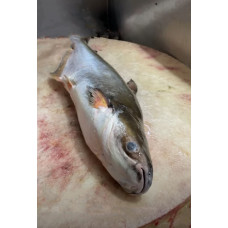Latin name
Arius gigas
Other names
Ewe, marine catfish.
Identification
Described by George Albert Boulenger in 1911, originally as genus Tachysurus.
Body elongate and rounded; head broad and only slightly flattened from above, snout rounded (slightly pointed in small individuals); mouth lowered; maxillary antennae reaching only to the base of the pectoral fins, mandibular antennae shorter; bony skull shield, clearly visible through the skin, coarsely wrinkled, very small median keel; occipital process moderately broad at base and truncate posteriorly. Base of supraoccipital process moderately broad. Predorsal plate wrinkled, sickle-shaped; maxillary teeth tufted, forming 2 plates converging on the midline; palatine teeth in the form of 2 large subtriangular plates only slightly separated on the midline; gill blades absent on posterior surface of 1st and 2nd arches; total number of anterior gill blades on first arch from 18 to 21, on second arch from 18 to 20.
Features of fish fins
Dorsal spines (total): 2; Dorsal soft rays (total): 7; Anal soft rays: 11-13. Dorsal and pectoral fins with strong, bony, erect spines, anterior margin granular and posterior margin serrate; long dorsal fin spine preceded by very short one; adipose fin well developed; caudal fin forked, upper blade slightly elongated.
Fish colouring
Coloration: bluish-gray on top, gradually paler towards the belly, which becomes white; distal edge of fins blackish.
Distribution
Occupies brackish and freshwater habitat in Burkina Faso, Côte d'Ivoire, Cameroon, Benin, Mali, Ghana and Nigeria.
Habitat
A tropical benthopelagic species that prefers brackish and fresh waters.
Size
Its maximum overall length reaches 165 cm (65 inches) and its maximum weight is 50 kg (110 pounds).
Behavior
These fish are voracious eaters and very strong and agile swimmers.
Food and feeding habits
The diet includes crustaceans (crabs, shrimps), worms, fish, cephalopods, sea cucumbers, and mussels.
Reproduction
They spawn from April to August. The males carry the eggs in their mouths.
Fishing
The population of these fish has declined due to overfishing.
Relationship with a person
They are commercially important as food fish. They are classified as traumatic to humans.
| Classification | |
| Phylum | Chordata |
| Class | Actinopterygii |
| Squad | Siluriformes |
| Family | Ariidae |
| Genus | Arius |
| Species | A. gigas |
| Features | |
| Conservation status | Data Deficient |
| Habitat | Pelagic |
| Life span, years | No information |
| Maximum body weight, kg | 50 |
| Maximum length, cm | 165 |
| Sailing speed, m/s | No information |
| Threat to people | Edible |
| Way of eating | Predator |
Giant sea catfish
Tags: giant sea catfish

